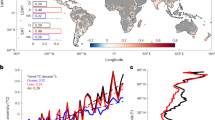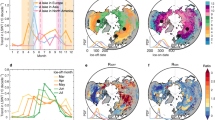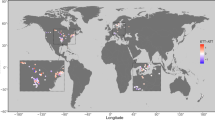Abstract
The impacts of climate change on the world’s large lakes are a cause for concern1,2,3,4. For example, over the past decades, mean surface water temperatures in Lake Superior, North America, have warmed faster than air temperature during the thermally stratified summer season, because decreasing ice cover has led to increased heat input2,5. However, the effects of this change on large lakes have not been studied extensively6. Here we analyse observations from buoys and satellites as well as model reanalyses for Lake Superior, and find that increasing temperatures in both air and surface water, and a reduction in the temperature gradient between air and water are destabilizing the atmospheric surface layer above the lake. As a result, surface wind speeds above the lake are increasing by nearly 5% per decade, exceeding trends in wind speed over land. A numerical model of the lake circulation suggests that the increasing wind speeds lead to increases in current speeds, and long-term warming causes the surface mixed layer to shoal and the season of stratification to lengthen. We conclude that climate change will profoundly affect the biogeochemical cycles of large lakes, the mesoscale atmospheric circulation at lake–land boundaries and the transport of airborne pollutants in regions that are rich in lakes.
This is a preview of subscription content, access via your institution
Access options
Subscribe to this journal
Receive 12 print issues and online access
$259.00 per year
only $21.58 per issue
Buy this article
- Purchase on Springer Link
- Instant access to full article PDF
Prices may be subject to local taxes which are calculated during checkout




Similar content being viewed by others
References
Hansen, J. et al. Global temperature change. Proc. Natl Acad. Sci. 103, 14288–14293 (2006).
Magnuson, J. J. et al. Historical trends in lake and river ice cover in the Northern Hemisphere. Science 289, 1743–1746 (2000).
Alin, S. R. & Johnson, T. C. Carbon cycling in large lakes of the world: A synthesis of production, burial, and lake-atmosphere exchange estimates. Glob. Biogeochem. Cycles 21, GB3002 (2007).
Cole, J. J. et al. Plumbing the global carbon cycle: Integrating inland waters into the terrestrial carbon budget. Ecosystems 10, 172–185 (2007).
Austin, J. A. & Colman, S. M. Lake Superior summer water temperatures are increasing more rapidly than regional air temperatures: A positive ice-albedo feedback. Geophys. Res. Lett. 34, L06604 (2007).
Austin, J. A. & Colman, S. M. A century of temperature variability in Lake Superior. Limnol. Oceanogr. 53, 2724–2730 (2008).
Levitus, S., Antonov, J. I., Boyer, T. P. & Stephens, C. Warming of the world ocean. Science 287, 2225–2229 (2000).
Assel, R. A. Great lakes ice cover, first ice, last ice, and ice duration: Winters 1973–2002. NOAA Technical Memorandum GLERL-125 (Great Lakes Environmental Research Laboratory, 2003).
Stull, R. B. An Introduction to Boundary Layer Meteorology (Kluwer–Academic, 1988).
Xie, S.-P. Satellite observations of cool ocean-atmosphere interaction. Bull. Am. Meteorol. Soc. 85, 195–208 (2004).
Back, L. E. & Bretherton, C. S. On the relationship between SST gradients, boundary layer winds and convergence over the tropical oceans. J. Clim. 22, 4182–4196 (2009).
Chelton, D. B. et al. Observations of coupling between surface wind stress and sea surface temperature in the eastern tropical Pacific. J. Clim. 14, 1479–1498 (2001).
Lindzen, R. S. & Nigam, S. On the role of sea surface temperature gradients in forcing low-level winds and convergence in the tropics. J. Atmos. Sci. 44, 2418–2436 (1987).
Wallace, J. M., Mitchell, T. P. & Deser, C. The influence of sea surface temperature on surface wind in the eastern equatorial Pacific: Seasonal and interannual variability. J. Clim. 2, 1492–1499 (1989).
Maloney, E. D. & Chelton, D. B. An assessment of the sea surface temperature influence on surface wind stress in numerical weather prediction and climate models. J. Clim. 19, 2743–2762 (2006).
Song, Q., Chelton, D. B., Esbensen, S. K., Thum, N. & O’Neill, L. W. Coupling between sea surface temperature and low-level winds in mesoscale numerical models. J. Clim. 22, 146–164 (2009).
Pavia, E. G. & O’Brien, J. J. Weibull statistics of wind speed over the ocean. J. Appl. Meteorol. 25, 1324–1332 (1986).
Klink, K. Trends and interannual variability of wind speed distributions in Minnesota. J. Clim. 15, 3311–3317 (2002).
Pryor, S. C. et al. Wind speed trends over the contiguous United States. J. Geophys. Res. 114, D14105 (2009).
Waples, J. T. & Klump, J. V. Biophysical effects of a decadal shift in summer wind direction over the Laurentian Great Lakes. Geophys. Res. Lett. 29, 1201 (2002).
Urban, N. R. in State of Lake Superior (eds Munawar, M. & Heath, R.) (Ecovision World Monograph Series, Aquatic Ecosystem and Health Management Society, 2009).
Mesinger, F. et al. North American regional reanalysis. Bull. Am. Meteorol. Soc. 87, 343–360 (2006).
Arya, S. P. Introduction to Micrometeorology Vol. 79 (International Geophysics Series, Academic, 2001).
Businger, J. A., Wyngaard, J. C., Izumi, Y. & Bradley, E. F. Flux profile relationships in the atmospheric surface layer. J. Atmos. Sci. 28, 181–189 (1971).
Charnock, H. Wind stress on a water surface. Q. J. R. Meteorol. Soc. 81, 639–640 (1955).
Marshall, J., Adcroft, A., Hill, C., Perelman, L. & Heisey, C. A finite volume, incompressible Navier–Stokes model for studies of the ocean on parallel computers. J. Geophys. Res. 102, 5753–5766 (1997).
Marshall, J., Hill, C., Perelman, L. & Adcroft, A. Hydrostatic, quasihydrostatic, and nonhydrostatic ocean modelling. J. Geophys. Res. 102, 5733–5752 (1997).
Schwab, D. J. & Seller, D. L. Computerized Bathymetry and Shorelines of the Great Lakes. NOAA Data Report ERL GLERL-16 (Great Lakes Environmental Research Laboratory, 1996).
Large, W. G., McWilliams, J. C. & Doney, S. C. Oceanic vertical mixing: A review and a model with a nonlocal boundary layer parameterization. Rev. Geophys. 32, 363–403 (1994).
Smagorinsky, J. General circulation experiments with the primitive equations. I. The basic experiments. Mon. Weath. Rev. 91, 99–164 (1963).
Acknowledgements
This work was supported by NSF Geosciences directorate Grant Nos 0628560 (A.R.D., V.B. and G.A.M.) and 0825633 (J.A.A.).
Author information
Authors and Affiliations
Contributions
A.R.D. developed the analysis framework, built the surface layer model, carried out the correlation analyses and wrote most of the manuscript. J.A.A. suggested the initial idea and analysed the buoy data. V.B. parameterized, ran and analysed the physical model of Lake Superior. G.A.M. designed the physical model framework and discussed lake biogeochemical implications. All authors discussed and revised the manuscript and figures.
Corresponding author
Supplementary information
Supplementary Information
Supplementary Information (PDF 397 kb)
Rights and permissions
About this article
Cite this article
Desai, A., Austin, J., Bennington, V. et al. Stronger winds over a large lake in response to weakening air-to-lake temperature gradient. Nature Geosci 2, 855–858 (2009). https://doi.org/10.1038/ngeo693
Received:
Accepted:
Published:
Issue Date:
DOI: https://doi.org/10.1038/ngeo693
This article is cited by
-
Spatial variation of diatom diversity with water depth at Huguang Maar Lake, Southern China
Journal of Paleolimnology (2022)
-
Global lake responses to climate change
Nature Reviews Earth & Environment (2020)
-
Lake superior sedimentary diatom profiles from the Medieval Climate Anomaly and twentieth century suggest recent assemblage changes reflect novel environmental conditions
Journal of Paleolimnology (2020)
-
Effective fetch and relative exposure index maps for the Laurentian Great Lakes
Scientific Data (2018)
-
Multiple climate regimes in an idealized lake–ice–atmosphere model
Climate Dynamics (2018)



